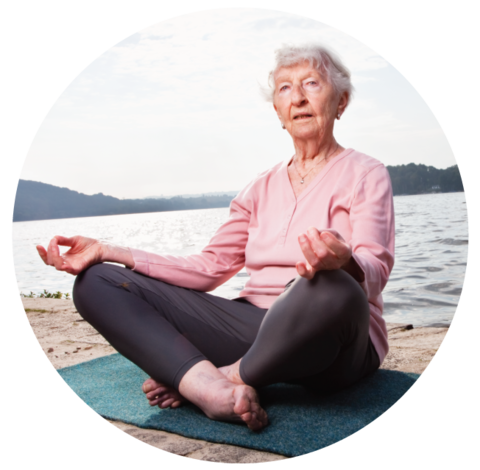
FAST FACTS: Controlled Breathing & Guided Imagery
Controlled Breathing and Guided Imagery is used to help reduce stress that can cause muscle tension and increase pain. You could consider recording your family member’s favorite music, poems, or prayers read by family members or clergy so it could be played at any time for stress reduction.
Directions:
-
Help your family member into a comfortable position.

- Instruct your family member to close their eyes
- Do not allow your family member to fold their arms or cross their legs to avoid reducing circulation.
- Read the following out loud, slowly:
- Breathe in slowly and deeply
- As you breathe out slowly, feel yourself beginning to relax; feel the tension leaving your body.
- Now breathe in and out slowly and regularly, at whatever rate is comfortable for you.
- To help you focus, breathe slowly. Breathe in as you say silently to yourself, “in, two, three.”
- Breathe out as you say silently to yourself, “out, two three.” Or, each time you breathe out, say silently to yourself a word such as “I am peaceful”, or “I am relaxed.” Find a word or phrase that helps you focus and slow your breathing.
- You may imagine that you are doing this in a place you have previously found very calming and relaxing, such as lying in the sun at the beach.
- Peaceful images may be added by asking one of the following questions:
- Can you remember any situation, even when you were a child, when you felt calm, peaceful, secure, hopeful, or comfortable?
- Do you get a dreamy feeling when you listen to music?
- Do you have any favorite music?
- Do you have any favorite poetry that you find uplifting or reassuring?
- If they are, or have ever been religiously active, you could ask: Do you have favorite readings, hymns, or prayers? Even if an individual hasn’t heard or thought of them for many years, childhood religious experiences may still be very soothing.
What Else You Should Do
- Write down and share information about your family member’s pain with their healthcare provider
- Use a Pain Diary to note important information useful to the healthcare provider
- Encourage your family member to try a non-drug treatment and document the impact on their pain in their Pain Diary
References:
- Adapted from: 1. Fouladbakhsh, J.M., et al., Nondrug therapies for pain management among rural older adults. Pain Manag Nurs, 2011. 12(2): p. 70-81. 2. The Nursing Home Pain Management Algorithm Clinical Trial, R01 NR009100,
- Quinn C. Guided imagery: An effective pain management tool for total joint replacement? Nursing (Lond) 2019; 49:57–59. doi: 10.1097/01.NURSE.0000580712.40392.cc. - DOI
Revised January 2022
